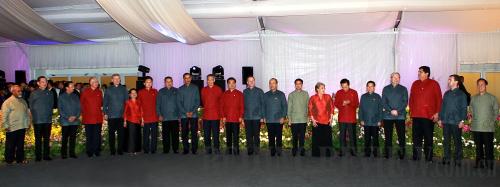|
 |
|
A BIG ASIA-PACIFIC FAMILY: Leaders of Asia-Pacific Economic Cooperation member economies gather at their 17th summit in Singapore on November 14, 2009 (JU PENG) |
Asia-Pacific economic integration seems destined to take on new dimensions. On March 15, officials from eight nations began talks in Melbourne, Australia, on the expansion of a trans-Pacific free trade agreement. The United States, Australia, Peru and Viet Nam are seeking to join the Trans-Pacific Partnership (TPP), which already includes Chile, Singapore, New Zealand and Brunei. In an article published in the Beijing-based World Affairs magazine, Yang Zerui, a researcher with the China National Committee for Pacific Economic Cooperation, pointed out that the TPP might offer a new approach to creating a free trade area in the Asia-Pacific region. Excerpts from this article follow:
Unlike the loose Asia-Pacific Economic Cooperation (APEC) forum, the TPP is a binding agreement aimed at achieving free trade with an incremental approach. In other words, instead of trying to pursue an across-the-board free trade agreement from the very beginning, TPP members have focused on the liberalization of certain economic sectors step by step. They are also ready to admit new members from the Asia-Pacific region.
The origins of the TPP date back to 1998 when some APEC members started exploring the possibility of establishing free trade among themselves following the failure of APEC's Early Voluntary Sectoral Liberalization initiative. Chile, Singapore and New Zealand inaugurated free trade negotiations four years later at the APEC forum in Mexico. The three countries signed the TPP in July 2005, and Brunei joined the pact a month later.
The four countries have placed high hopes on their free trading bloc. Singaporean Prime Minister Lee Hsien Loong said at an APEC meeting in November 2009 that he hoped this "little seed" would grow over time into a "significant tree and pillar" for free trade in the Asia-Pacific region.
The United States first announced its intentions to join the group in September 2008. In November 2009, President Barack Obama reaffirmed the United States would engage the TPP with the goal of "shaping a regional agreement that will have broad-based membership and the high standards worthy of a 21st century trade agreement."
The participation of the United States and other countries will surely bring about major changes to the TPP process. According to 2008 statistics, the four original members of the TPP have a total population of 24.4 million, accounting for less than 1 percent of the population of all APEC members. Their combined gross domestic products (GDP) amounts to $467.8 billion, representing less than 1.5 percent of the GDP of all APEC member economies.
If the United States, Australia, Peru and Viet Nam become members of the TPP, the group's total population and GDP would reach 463.4 million and $15.88 trillion, taking up 17 percent and 49 percent, respectively, of the APEC total.
Besides dramatic increases in its total population and economic power, America's status portends to be another bonus for the TPP.
Moreover, the eagerness shown by less developed APEC members such as Peru and Viet Nam poses a serious challenge to the stereotypical view that poor countries tend to resist free trade.
Some experts have predicted that Canada, Mexico, Japan, South Korea, Malaysia and Indonesia may also join the TPP in the foreseeable future.
| 